How to repair the drain pump yourself: an overview of frequent breakdowns
A drainage pump in a suburban area is a kind of lifesaver in case of unforeseen situations. By design, it resembles equipment for drinking water, but it has the ability to move contaminated media with large inclusions.
But like any other equipment, equipment can fail. Let's try to understand the weaknesses of the unit and find out whether it is possible to repair the drainage pump with your own hands if necessary.
The content of the article:
Typical drain pump design
The ability to pump water with fine gravel, a large inclusion of sand, organic residues is a very useful quality when you need to pump out water after flooding or drain the pond. Drainage units are designed to operate in such conditions, but excess load often leads to breakdowns.
It is better to get acquainted with the internal filling of the device immediately after purchase in order to imagine what parts can fail in case of clogging or breakage. To do this, it is not necessary to open the case or disassemble - just study the diagram that is attached to the instructions for connecting and servicing the device.
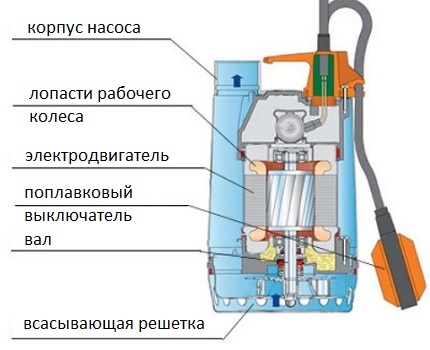
Devices for private use in suburban areas do not differ in high power or complex filling. Unlike heavy industrial equipment, they are compact, relatively light (average weight - 3-7 kg), consist of steel or plastic parts, although cast iron is still used for the production of industrial models and some household ones.
The main components of the submersible mechanism are a pumping unit pumping water, and an electric motor rotating a shaft with blades. The engine is located inside a sturdy case, which is made of stainless steel or reinforced polypropylene and is double. Between the outer and inner walls, water circulates, preventing cooling.
Modern models are equipped with thermal protection that is triggered when the device is overloaded. An impeller is attached to the axial shaft - a screw device that feeds liquid into the housing. When the unit is turned on, the impeller starts to rotate, take water from the outside and push it along the walls to the outlet. The first portion of water is replaced by the next - and so on until the mechanism stops.
Regulates the frequency of work float switch. It monitors the level of liquid in the tank or natural body of water, with a sharp decrease it turns off the device in automatic mode.
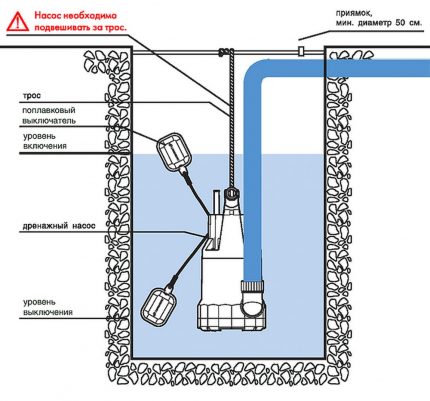
As you can see drainage pump device simple enough, and if you ever disassembled and cleaned a submersible well pump, you can handle this category of equipment. The fecal aggregate is a little different, having an additional unit for grinding too large particles.
Differences between submersible and surface models
The submersible is useful for cleaning deep reservoirs, for example, just commissioned well. The first liquid accumulated in it cannot be called drinking, since there are many large inclusions of sand and clay. During the day, it is necessary to pump out contaminated liquid so that clean, usable water comes in its place.
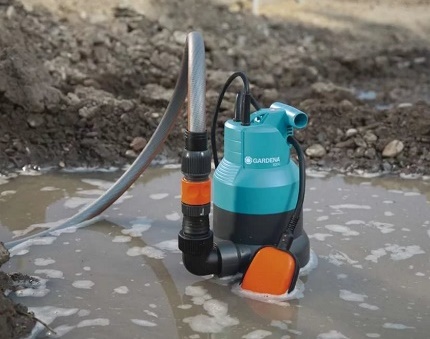
Unlike submersible, surface pump do not use for deep reservoirs, it is more suitable for pumping water from a pool or basement - when it is flooded. A hose is placed at the bottom of the tank to receive dirty water, and a second hose is used to drain drains.
If the pump is used in an emergency, it is appropriate to use a float device that will monitor the critical level of water rise. The plus is that the design of the mechanism allows pumping liquid with large pieces of dirt - up to 5 cm (less often - 10 cm).
It is clear that the surface type aggregate differs in its structure. Inside the metal case, the working shaft and wheel are fixed, and the engine can be different: for centrifugal products - single-phase with external ventilation, self-priming - asynchronous bipolar.
Despite the contamination of the pumping medium, you should not allow the pump to work with a liquid in which gasoline, kerosene or other petroleum products and chemicals are dissolved.
Causes of damage to the drainage pumps
Both new equipment and one that has served for more than one year can break. The device you just bought may fail due to a manufacturing defect made during assembly: a damaged piston or a valve that is not connected correctly.
Often breakdowns occur due to inept installation if:
- lowered the unit to an insufficient depth;
- allowed air to enter the water intake compartment;
- the water inlet is above water and not covered by liquid.
These shortcomings are easily corrected by a simple check, but it is better not to allow them.
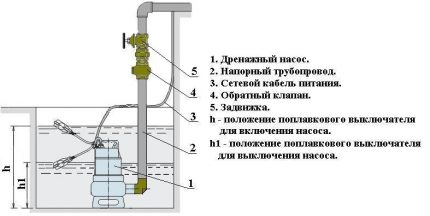
Most often, problems arise during the operation of equipment. The manufacturer sets the control parameters within which it is necessary to act (they are declared in the technical passport of the product). If the equipment is used incorrectly, for other purposes, it simply cannot withstand the load.
For example, for the drainage apparatus is the norm pumping dirty water. This means that problems can arise if you start moving clean drinking water (for which you are intended downhole and well models) On the contrary, too large contaminations clog the filters, as a result of which the pump stops working.
Also, troubles are expected if the equipment is idling, in the "dry" mode - overheating will happen, which can not always be fixed on your own. As a result of a mistake, the case may result in expensive service repairs.
Lack of prevention, rare technical inspections can also cause damage. Many troubles can be avoided by warning them by replacing one of the parts or elementary cleaning.
Faults and solutions
There are a number of opportunities to repair the equipment with your own hands, provided that the broken part can be replaced with a new one or a simple technical procedure can be performed (for example, cleaning). To do this, you will have to disassemble the case, perform diagnostics, identify the problem and select the identical part.
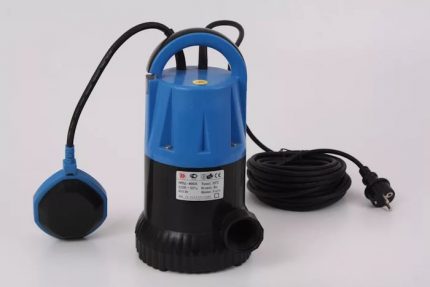
Available actions include replacing a capacitor, impeller, or float, repairing an electrical cable, fixing a shock absorber, removing large pieces of clay and sand stuck inside the case.
If the cast-iron housing cracked, the valve failed or the winding stopped functioning, you should contact a service center or think about buying a new pump. Inexpensive Chinese-made drainage devices are inexpensive, so ordering a serious professional repair is not practical.
Breakdown # 1 - power cord is out of order
A flexible element - a cable - is always at risk, because due to regular twists and bends (which often happens when transporting and reinstalling equipment), wires under a layer of plastic or rubberized protection break, resulting in a power outage to the pump.
It is necessary to find the gap and make the connection. This operation is easy to carry out if a break occurs near the plug - you just need to strip and connect the wires, finally carefully isolating the place of work.
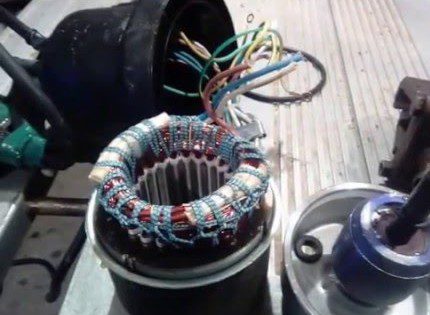
A cable break in the connection area to the pump requires more time to repair. First, you need to remove the equipment from the water, wipe and dry it, then disassemble it to get to the indoor unit. Get ready for the fact that instead of hexagonal holes you will encounter triple holes, which will make it difficult to choose a screwdriver.
The cover should be removed carefully, without jerking and effort. By unscrewing the bolts holding the tension element, you can examine the cable and determine the area of the gap. We remove the worn-out piece, mount the cable in its original place, fix the tension element, fix the bolts.
Breakdown # 2 - water supply has stopped
The engine is working properly, however, the fluid has either stopped flowing altogether, or comes in in small irregular jerks.
There may be several reasons for the strange phenomenon:
- Part of the supply line is clogged. This is a discharge pipe or feed pipe. A kind of blockage arose from bundles of algae and pieces of clay. Disconnect pipes and clean them. Perhaps the length of the pipe is longer than recommended by the manufacturer, and therefore there is not enough pressure to pressure the required power.
- The impeller is worn out. The blades are bent or damaged. It is necessary to disassemble the device, replace the parts, to begin with visually (as far as possible) identifying the cause of the malfunction.
- The fluid is oversaturated with dirt and debris. Therefore, the water has a thick consistency and is difficult to pump. We solve the problem by raising the suction port a certain distance from the bottom, where sediment accumulates.
- Significantly decreased engine power. What can be determined even by sound. There may be problems in the supply of electricity, failure of the bearings, depressurization of the oil compartment. It is necessary to disassemble the case in order to clarify the cause of the breakdown and replace worn parts.
The most common problem is a clogged filter. To clean the screen and the suction port, you can try passing some clean water through the pump. If this procedure does not help, you should disassemble the case and clean all the chambers, removing pebbles, algae and slivers.
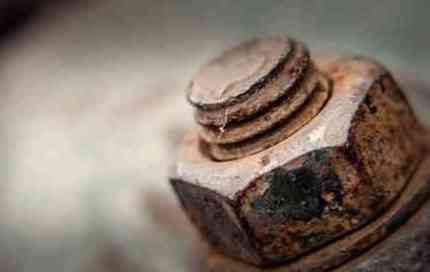
When disassembling the unit, be sure to use the manufacturer's diagrams or instructions. They will help to sequentially remove parts, quickly find places of fastening of bolts.In some cases, wear of the fasteners or loosening of the nuts causes displacement of the parts, which also affects the performance of the device.
Failure # 3 - the engine does not start
You turn on the power - and the pump does not work, does not make noise and does not pump water. Get ready to have to examine all the equipment.
Here are the most common causes of engine failure:
- Power failure due to wire breakage. We check the cable by touch and find the gap. If the emergency section is in the zone of connection to the pump, proceed as described above.
- Stator winding failed. It happens because of the work "dry." If you cannot replace it yourself, contact a specialist.
- The bearing is jammed. We check the part for suitability, according to the results of diagnostics, we clean or change it.
- Suction device clogged with debris. We clean the blades and gratings, check the integrity of the existing elements and mesh.
- The float switch has broken. To check its operation, it is necessary to close the relay. There may be a problem in the wire connecting the float to the pump.
If the capacitor fails, a replacement is required. In some models, special access is provided to it, which is a separate hole in the housing.
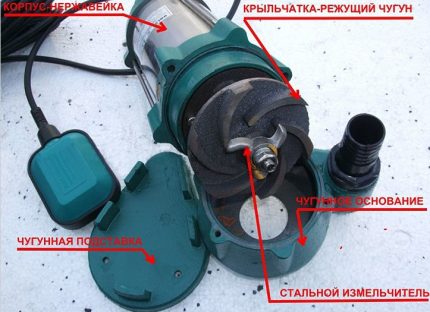
Breakdown # 4 - the pump shuts itself off
When you turn on the pump in the network, it starts to work, however, after some time, it stops spontaneously. Most likely, the protective mechanism is triggered due to overheating of the engine.
Perhaps the cause is a heating cable. It is worth checking the correspondence of the mains voltage and the parameters set by the manufacturer. If the data do not match, you need to purchase a stabilizer.
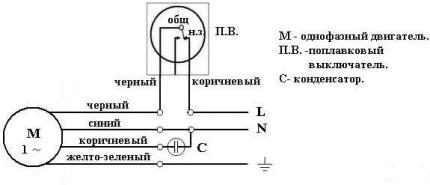
Shutdown can also occur due to clogging of the blades with garbage. In this case, we recommend that you complete the cleaning procedure, that is, open the housing, clean the inner chambers and impeller, and check the filter.
If blockages occur quite often, re-read the instructions for the product to determine the size of the fractions. Perhaps the pump is not designed to pump liquid with large particles of debris - only a fecal pump is suitable for grinding
Failure # 5 - turning on the pump knocks the electrician out
When the pump is turned on, plugs fly out or wires burn out. The reason is to look in the details that are directly responsible for the electrical wiring - cable or stator winding. The serviceability of the wires can be checked with the help of a tester, if a worn section is found, the entire cable should be replaced or (if the gap is near the end) shorten it.
Repair of a winding is a laborious and requiring special knowledge. Even with a neatly conducted secondary winding, a short circuit cannot be ruled out. If you have no time to tinker with a burnt out part, take the device to a service center - perhaps after a diagnosis they will advise you to buy a new pump.
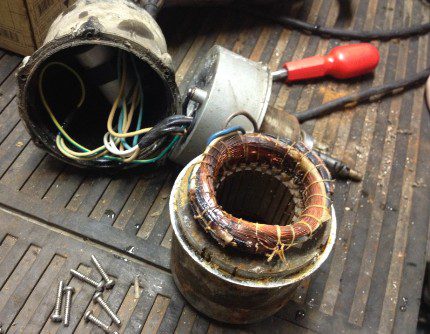
Preventive measures and regular maintenance
As you can see, the cause of wear of parts can be inevitable wear, and violation of the rules of operation of the equipment. To make the device last longer, try to follow the manufacturer's recommendations. For example, position the housing so that the suction device is a certain distance from the base of the tank and does not trap particles of a large fraction.
At least once a year, check the serviceability of the cable and internal parts, disassembling the case as much as possible. Perform preventative cleaning, which will increase the service life of parts by several times. Do not confuse the drainage device with the fecal one - it does not have a special grinder and can not cope with the movement of large inclusions.
Conclusions and useful video on the topic
Video clips from craftsmen will help you organize the disassembly of pumps of various brands and eliminate malfunctions yourself.
Stator overheating due to violation of the interval operating mode:
Features of the repair of the Pedrollo pump:
How to repair the Whirlwind drain pump:
Disassembly of the Praktika DNG-400 pump:
Repairing the drainage pump with your own hands is quite possible and desirable if it is enough to clean or replace the spare part to fix it. Complicated emergencies - rupture of the housing or rotating shaft - cannot be repaired independently. Elimination of serious problems must be entrusted to specialists, and if replacement is not practical, then buy a new pump.
If after studying our material there are questions, or you have encountered a breakdown of the drainage pump and know how to get out of this situation, please leave comments. We are very interested to know your opinion.

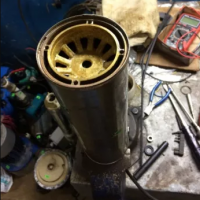 Do-it-yourself repair of the Aquarius pump: an overview of typical breakdowns and their elimination
Do-it-yourself repair of the Aquarius pump: an overview of typical breakdowns and their elimination  Do-it-yourself water pump repair: an overview of the most popular failures
Do-it-yourself water pump repair: an overview of the most popular failures 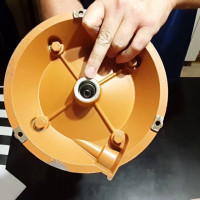 How to repair the Agidel pump: an overview of typical breakdowns and how to fix them
How to repair the Agidel pump: an overview of typical breakdowns and how to fix them 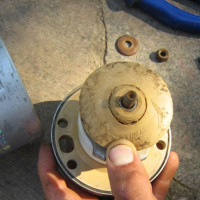 Do-it-yourself kid pump repair: an overview of the most popular failures
Do-it-yourself kid pump repair: an overview of the most popular failures 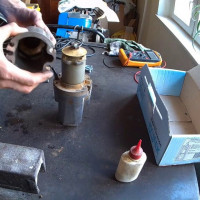 How to repair the Do-it-yourself Pump repair: repairing popular breakdowns
How to repair the Do-it-yourself Pump repair: repairing popular breakdowns 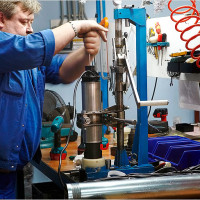 Repairing the Gnome pump
Repairing the Gnome pump  How much does it cost to connect gas to a private house: the price of organizing gas supply
How much does it cost to connect gas to a private house: the price of organizing gas supply  The best washing machines with dryer: model rating and customer tips
The best washing machines with dryer: model rating and customer tips  What is the color temperature of light and the nuances of choosing the temperature of the lamps to suit your needs
What is the color temperature of light and the nuances of choosing the temperature of the lamps to suit your needs  Replacement of a geyser in an apartment: replacement paperwork + basic norms and requirements
Replacement of a geyser in an apartment: replacement paperwork + basic norms and requirements
Hello! There was a problem - disassembled the pump, the bearing was covered. The man replaced ... I did not disassemble the engine ... and after all the procedures done, the engine was spinning in the opposite direction - what caused this?
The capacitor is not connected so most likely, swap the contacts.
Good afternoon. Well, maybe you can, but you’ve entered the float, but don’t pump the water, but how can you take the float into the air at once repairing the pump?
Swap the ends of the working winding
Hello, the pump starts, it works for 2-3 seconds and stalls.
Good time. Most often, the drainer stalls if the impeller is blocked by something. Apparently, the pebble hit, but this is at best. Worse, if a capacitor or motor is broken, it is necessary to carry these problems to the workshop.
The electrical cable broke on the drainage pump near the housing, replaced. How to seal the connector between the cable and the housing?
Hello. Shrink adhesive clutch, are expensive, about 1000 rubles, but your life is also dear to us 🙂 Good luck!
Hello! A malfunction appeared - when lowering the float, the pump did not turn off. Replaced the float, the problem did not disappear. What could be the reason?
KLEVER 400W pump breaks the cable in the housing, I can not take it apart to replace it. There is no fastener on top. How to get to the cable?
Unscrew from the bottom, there should be 4 more screws.
Good evening. Please tell me, the drain pump has stopped turning on. I disassembled the upper part where the wires and the capacitor are all wet. There was no short circuit ...
Hello. Most likely, the protection worked and therefore the circuit did not occur.What to do ... Disassemble, dry and look, where it is oxidized, clean, inspect the engine as well. Make a ringing system. If you yourself can not figure it out, contact the wizard.
There isn’t the most important thing in the topic - how to correctly and correctly fill the grease in the stuffing box so that water does not get into the pump?
Hello. Such a topic requires a separate lengthy article. We will warn the administrator that our guests are interested in her and I think she will appear on the portal soon.
Good evening. Tell me, the pump is buzzing, but not spinning. He did not jam.
Alexander is most likely a stator winding or conder.
Hello. Faced a problem. The fecal tracker rotates but does not draw water. It rotates in the right direction, submerged completely under water. Immersion depth approx. 1000mm. The height of the water rise is approximately 4000 mm. pipe diameter 50 mm. Tell me, what could it be?
Hello. The problem with windings, check valves, loose parts, wipes, rags, large pieces of toilet paper that the pump cannot pump through the pipe diameter (recently encountered this). If possible, check in clean water.
Where can I buy an engine for a submersible pump?
Hello. In stores where they sell pumps, they also often sell spare parts. You can ask to bring to order. Depending on the manufacturer, sometimes you can make an order with an official supplier on the company's website. You can also use the services of an online store, but look at customer reviews.
Belamos Omega 25 drainage pump: when turned on, the shaft does not spin, the pump buzzes. If you give a small rotational force to the impeller, the pump starts to pump normally. Tell me, what can I do on my own? Or carry in repair?
Hello. Inspect the impeller for damage on your own. If in doubt, bring it in for repair or just ask a knowledgeable person to look.
Hello! When turned on, the PATRIOT F400 pump buzzes, but does not turn the shaft, the Conder has already changed (serviceable). If you give rotation to the shaft during a buzz (spin), it starts to work. What could be the problem?
Hello. It is difficult to assume without diagnosis. Conder changed early, there if the impeller spins easily by hand - the first suspicion of him, but if jerky, then the reason is different. In your case, parsing and dialing to break the starting winding is necessary.
Good afternoon. I have such a problem. Pump Whirlwind DN900 has stopped working. The engine hums, but does not start. After opening, I found water inside the case (where all the wires are). There was a lot of water, also water flowed out of the engine. When the pump is turned on, the engine starts and runs only if you turn the pulley by hand. In this case, the engine does not smoke, and does not break through the current. Tell me how you can reanimate the pump and where to start the repair?
Hello. Does the engine start manually, and does the drone go before such a start? Disassemble the pump and inspect for oxidation and, first of all, pay attention to the impeller. Most likely, the problem is in this area.
Drainage pump Opera. The engine is buzzing. The shaft tries to twist in small jerks, but does not twist. The impeller is intact. What could be the problem?